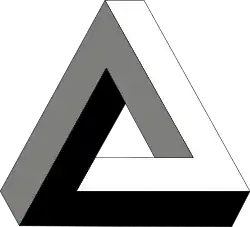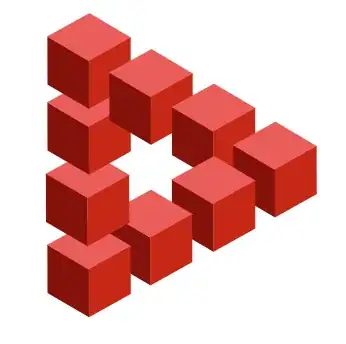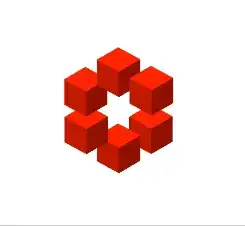I remember seeing this shape as a kid in school and at that time it was pretty obvious to me that it was "impossible". Now I looked at it again and I can't see why it is impossible anymore.. Why can't an object like the one represented in the following picture be a subset of $\mathbb{R}^3$?
6 Answers
I can't resist posting an answer based on the Mathematics Stack Exchange logo.
Let's add some more cubes to the logo to make it clear that it's a subset of the Penrose triangle (or would be, if it was a real 3D object)
Now note that the cubes are overlapping, so some must be in front of others. But in fact, each cube is partially obscured by at least one other cube, in such a way that it appears to be some distance behind it. You can go around the hexagon in the original logo, in clockwise order, and see that each cube appears to be located further from the 'camera' than the next one in the cycle - which means that each cube is in front of itself. There's no consistent "z ordering" that you can give to the different parts of the figure, and that's one way to see that it's impossible.
In reply to some of the comments, just to be explicit, the point here isn't just that the cubes all overlap each other. If that was the case it would be incorrect, since it's possible to have mutually overlapping arragements of cubes, as in this image provided by Misha Lavrov.
However, if we're assuming that the Stack Exchange logo is a subset of the Penrose triangle then we know the cubes aren't arranged like that. Instead, each cube is positioned so that some of its sides are coplanar with those of the next cube, and each cube is separated from the next by some distance in the z direction, where z is perpendicular to the plane of the image. Therefore the cubes' centres of mass can't be given consistent z coordinates.
As an extra bonus point, even if we don't assume that, and instead assume that each cube is as close to the next as it can be (in the z direction) without the surfaces intersecting, the Math.SE logo still can't be made into a consistent 3D shape, as the following animation shows. Note that it doesn't quite form the Math.SE logo, since one cube ends up in front of all the rest. Of the six neighbouring pairs of cubes, three of them can have equal z coordinates, but for the remaining three pairs, one cube unavoidably has to have a greater z coordinate than the next.
As another additional bonus point, although it's not possible to embed the Penrose triangle into normal, flat, Euclidean 3D space, it is possible to embed it into curved three dimensional space. The video below, by @ZenoRogue on Twitter, shows Penrose triangles embedded into something called "nil geometry". I don't pretend to understand the details, but it's a kind of curved space such that Penrose triangles really are possible.
video link: https://www.youtube.com/watch?v=YmFDd49WsrY
screenshot:
- 7,182
-
10
-
5But ... you can have three cubes, where $A$ is in front of $B$ is in front of $C$ is in front of A, in the sense that $A$ partially obscures cube $B$ when you're looking at it.. With the cubes in the same orientation as your picture, put cube A with its bottom front corner in the center of the top face cube B, and put cube C so that its top left corner is in the middle of the right face of cube A. – Peter Shor Jul 03 '20 at 16:21
-
23I feel like this is missing something since it's possible to have a set of 3d objects where each one is in front of and behind another. For example, when folding the sides of a cardboard box to close it: https://assets-global.website-files.com/5e136d26c5e98c478100e1c7/5e7504bffdfde87684302b74_no-tape-moving-box.jpeg. – mowwwalker Jul 03 '20 at 16:51
-
1@mowwwalker sure, but if you look at how the cubes are drawn, they appear not just to partially occlude each other, but to be actually located some distance behind each other in space. As in, if the figures actually represented real cubes in the way they appear to, their centres of mass would be at substantially different distances from the 'camera'. – N. Virgo Jul 04 '20 at 01:57
-
2Another interpretation of this image would be, if you label sides of the cube as X, Y, Z corresponding to the axes: you move 3 steps on the X axis, 3 on the Y axis, and 3 on the Z axis, which doesn't leave you back where you started. At least that's why this image looks suspicious to me. (Of course, this is then just a really good illustration of the answer by John Bentin) – Milo Brandt Jul 04 '20 at 02:34
-
@PeterShor after your comment I had to check, and it turns out that it's not possible to make the math.SE logo as a real 3D object using that trick. (Too bad - I'd have made a 3D printed one otherwise.) Here's an animation to show what I mean: https://gifyu.com/image/QTQd – N. Virgo Jul 04 '20 at 13:07
-
9Here is a "possible triangle" with three cubes: https://i.stack.imgur.com/cSCg0.png Yet I feel like the same argument as in this answer (each cube is partially obscured by another) could be made for it, so this answer proves too much... – Misha Lavrov Jul 04 '20 at 15:44
-
There is probably a way to make this rigorous, but it's not satisfactory to me as stated. The comments have already pointed out why the argument falls short. – Caleb Stanford Jul 05 '20 at 02:11
-
@MishaLavrov did you view the animation in my previous comment? I made it specifically to address that issue, which was raised previously by Peter Shor. – N. Virgo Jul 05 '20 at 05:37
-
Okay, but just because one way to do it doesn't work, doesn't mean that there is no way that works. – Misha Lavrov Jul 05 '20 at 05:39
-
@MishaLavrov in my animation, the cubes are as close to each other (in the z direction) as they can be without intersecting each other. So in this particular case, the fact that that way doesn't work does imply that no other way will work. – N. Virgo Jul 05 '20 at 05:40
Start at the bottom left-hand corner, taking othonormal unit vectors $\pmb i$ horizontally, $\pmb j$ inward along the cross-member bottom left-hand edge, and $\pmb k$ upward and perpendicular to $\pmb i$ and $\pmb j$. I'll take the long edge of a member as $5$ times its (unit) width; the exact number doesn't matter. Then, working by vector addition anticlockwise round the visible outer edge to get back to the starting point, we have $$5\pmb i+\pmb k+5\pmb j-\pmb i-5\pmb k-\pmb j=4\pmb i+4\pmb j-4\pmb k=\pmb0,$$which of course is impossible.
- 18,454
-
7
-
28Note also the "real-world" versions of this object are designed so that the total vector displacement (such as $4 \hat{\imath} + 4 \hat{\jmath} - 4 \hat{k}$ in your example) is along the line of sight, and so is visually perceived as the zero vector. – Michael Seifert Jul 03 '20 at 19:08
-
2I don't see where you get the $+\mathbf{k}$, $-\mathbf{i}$, $-\mathbf{j}$ terms from to begin with. I would make this whole argument simpler: the three blocks are orthogonal and of equal length; call them $\mathbf{i}$, $\mathbf{j}$, $\mathbf{k}$; then the closed-loop displacement is $\mathbf{i} + \mathbf{j} + \mathbf{k}$, which is clearly non-zero, i.e., impossible. – Noldorin Jul 03 '20 at 20:21
-
2@Noldorin : The terms you cite correspond respectively to the bottom right, top, and bottom left (short) edges in the OP's diagram. I'm not sure quite what a “block” is, or how such blocks could be added. However, if we consider the three corner cubes, each common to two members (like the cubes added in Nathaniel's answer), then the three (mutually orthogonal) vectors between the cubes' centroids perhaps could represent each block, and they would sum to zero. While I agree that three vectors are simpler than six, I preferred to use easily defined vectors along the visible edges. – John Bentin Jul 03 '20 at 22:10
-
2@JohnBentin Ah, I understand what you mean now. "along the cross-member bottom left-hand edge" had me slightly bewildered — in particular, I didn't know what you meant by "cross-member". (Maybe you could clarify for others reading, but up to you.) That said, I think your approach is a good one, since those vectors are easier to define and envisage, as you say. I probably should have written "beam" instead of "block" above (one of three), but the fact these are 3D beams and not 1D edges makes an approach like yours better, so I take back what I wrote! – Noldorin Jul 03 '20 at 22:21
-
(My $\mathbf{i}, \mathbf{j}, \mathbf{k}$ vectors would have to cut through the beams, which is indeed awkward.) – Noldorin Jul 03 '20 at 22:21
-
I’m really having trouble following this :( What is the cross-member bottom lefthand edge? Or is there a way you could create a graphic to accompany this? – gen-ℤ ready to perish Jul 05 '20 at 00:59
-
5I agree with the comments that "along the cross-member bottom left-hand edge" is very unclear. Took me a full minute to decipher. You could edit to (1) first explain what you mean by a member, or alternatively just draw a picture. – Caleb Stanford Jul 05 '20 at 02:15
-
Assume the white part is facing upwards. This is without loss of generality, since it just represents a specific rotation of the whole thing, which can't affect whether a shape is possible or impossible.
Now we know both the right and bottom columns (in the image) are on the same vertical plane / level (since they share the white horizontal surface).
Based on the connection between the left and right columns, we also know the left column extends downwards from the above plane (since it's on the opposite side of a side that's facing upwards).
This implies at least part of the bottom column is below the right column.
But we've already established they're on the same vertical plane, so we have a contradiction.
Thus this shape can't exist in 3D.
This is of course based on the assumption that each part of the image filled with a single solid colour represents a flat (uncurved) continuous surface and adjacent surfaces are connected at the same points as in the image and they point in different directions.
- 418
-
4+1 for pointing out the underlying assumption. Without this assumption, I'm pretty sure you could produce a connected solid shape that was topologically equivalent to the Penrose triangle - though the geometric shape would be different. – Robin Saunders Jul 03 '20 at 16:40
-
@RobinSaunders A torus is topologically equivalent to the Penrose triangle. :-) (The 'twist' in the shape comes out in the wash...) – Steven Stadnicki Jul 04 '20 at 02:27
-
-
Yes, making the assumptions explicit is important. Otherwise this would be a solution: https://youtu.be/CVOU8OTcgOQ – ThomasW Jul 05 '20 at 06:18
It's helpful - as is often the case - to boil the picture down to something simpler. In this case, let's just think about three particular polygons sitting in $3$-space: the (visible) black, white, and grey $L$-shapes. These are themselves contained in three planes, which I'll call $P_b, P_w, P_g$ respectively.
Now let's think about how these planes intersect - say, $P_b$ and $P_w$. We have one visible intersection, namely the "front" edge of the bottom cylinder where the black and white shapes themselves meet. However, we also have another intersection: if we "continue" the top of the black $L$, it will eventually meet the white $L$ at its top. So in fact $P_b$ and $P_w$ intersect in two distinct lines, and in particular they have at least non-collinear three points of intersection. But two planes which intersect at three non-collinear points must be the same plane - and that can't be the case here, since the black and white shapes clearly meet at right angles.
- 245,398
-
-
1I can't quite say how, but I feel like this is relevant: https://commons.wikimedia.org/wiki/File:Perth_Impossible_Triangle.jpg – Burnsba Jul 03 '20 at 15:18
-
@Burnsba The "right-facing" plane is no longer a plane, but actually two planes whose normals point in different directions. – user76284 Jul 03 '20 at 20:56
-
@user118161 I am not sure what you mean. Any analysis of the figure in question has to further interpret it, since certainly we can in reality produce objects which look like the figure in question (see Bumsba's comment). Any answer has to translate the drawing into some precise description of a mathematical configuration - either in terms of a family of vectors satisfying some algebraic relationship, or in terms of some family of planes satisfying some geometric relationship, or whatever. I have written colloquially, but this is ultimately no less rigorous than any of the other answers. – Noah Schweber Jul 03 '20 at 21:09
-
2Put another way, the question itself isn't fully rigorous as written since it doesn't actually say what a Penrose tile is precisely. A rigorous version of the question would be e.g. "Why can't we have in $\mathbb{R}^3$ a set of three square-based prisms such that [intersection conditions]?" The process of teasing out the "implied conditions" is necessary to answer the question; for me, I read the picture as implicitly declaring that the various "faces" are in fact flat and do in fact meet at right angles as suggested. – Noah Schweber Jul 03 '20 at 21:15
-
(In my previous comment, "Penrose tile" should of course be "Penrose triangle.) – Noah Schweber Jul 04 '20 at 17:13
This is only impossible because we try so hard to see three dimensionality in the figure.
As I read through the answers and stared at the figure, it ceased to be 3 dimensional, and instead became Three identical asymmetrical V-shapes lying flat on a plane. Easily describable, easily drawable, and completely flat.
Our experience has trained our optical neural nets to see three dimensionality, and it generally serves us well. In this case, the local fit with three dimensional corner shading bumps into our higher-level matching against known figures, and the tension is born. Clearly this is a trivially possible figure -- it appears several times in the question and answers. It is our perception and expectations that are wrong.
- 151
Imagine keeping the corners in the same place, but reducing the width of the square cross-section of each side down to zero, until each side is a one-dimensional line segment. You would end up with a triangle with three $90^{\circ}$ angles, which is impossible in Euclidean space $\mathbb{R}^n$.
- 5,787






Because two dimensions can't in fact represent three much more than a flat map can represent the world sphere, even with Mercator projection.
– Robbie Goodwin Jul 03 '20 at 21:57